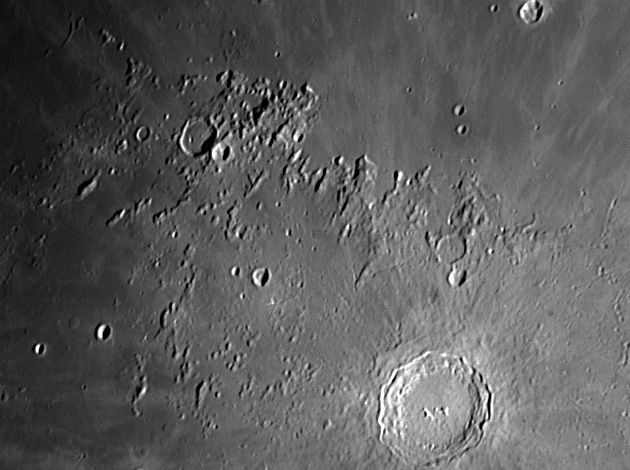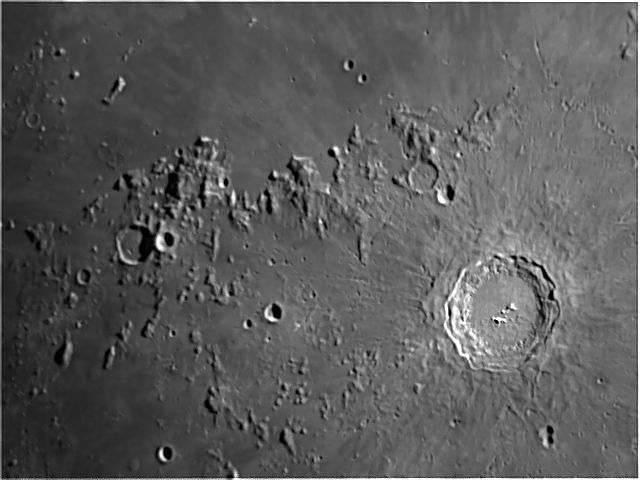The Carpathian Mountains 
Move your mouse over the picture to see the names of the various features.
The Carpathian Mountains are the south-west boarder of the Imbrium Basin. Mountain chains on the Moon are generally named after mountain ranges on Earth. It can be instructive for terrestrial geography to find those ranges. (The Carpathians are in eastern Europe.)
Note: The first image below and its commentary were made almost 12 years ago and have, for some strange reason, remained hidden in my archives until I came to add the later picture below. The commentary was valid at the time but much has happened since then and the second commentary brings things up to date (as of May 2022). Most importantly we now have access to the Lunar Reconnaissance Orbiter Altimeter which helps to resolve details not previously readily available. The apparent discrepancies in my reported elevations arises because the heights of mountains around the Imbrium ring are generally relative to the level of the Imbrium lavas. However the LRO altimeter gives heights relative to the mean lunar radius and, on that scale, the elevation of the Imbrium lavas is between -1600 and -2700 metres. (The lava plains are by no means level. They may have been formed by liquid lava flowing into the basin, but this did not happen all at once, but was built up in a succession of waves a few million years apart, and the lava must have solidified quickly.)

|
The Montes Carpatus represent the south-western boundary of the great Imbrium basin. They are 290 Km long and rise to 2400 metres, which is quite low compared to the other great mountain chains outlining Mare Imbrium; the Juras rise to 6000 metres, the Apennines to 5400 metres, and the Caucasus to 3650 metres. There is a conspicuous lack of mountains on the western side of the Imbrium basin and one wonders what happened to the mass that must surely have been thrown up my the massive Imbrium impact.
In some ways the most interesting crater in this picture is Pytheas (incorrectly spelt in the mouseover), right at the top. There is a detailed picture in the VMA, taken by one of the Apollo missions, that shows Pytheas to have what looks to me like near vertical walls right to the floor, one of which cuts the edge of a small crater.
The picture was taken in the infra-red with a ToUcam attached to my LX200 on 12th November 2005 at 18:20 UT, when the Moon was 11.4 days old.
Date and Time: 12th November 2005 18:20 UT
Camera: ToUcam 740K
Telescope: LX200 at prime focus with IR-pass filter
Capture: K3CCDTools. Low gamma, 1/33", 33% gain, 453 frames
Processing: Registax. 138 frames stacked. Wavelets 1 = 10, 2 = 5, histogram 0-200
|
|
I have looked at Pytheas with the LRO Altimeter and the slopes of Pytheas are no steeper than any other crater. It is strange how steep these slopes can look in pictures but when I measured the slope at four places the steepest part of the slope varied from 25° to 27°, which is about 1 in 4. I doubt you would have any difficulty walking down such a slope.
|

|
Although they are small compared to the Apennines, the Carpathians are similar to the Alps which form the north-east boarder of the Imbrium basin. Using the Lunar Reconnaissance Orbiter Altimeter, the highest point I could find in the Carpathians is an unnamed mountain just north of Guy-Lussac crater (see mouseover) at an elevation of 1044 metres above the Moon's mean radius. This compares with 1017 metres for an unnamed mountain north of Mont Blanc in the lunar Alps. The western part of the Imbrium ring is missing completely, and to me that indicates that the Imbrium basin formed on a pre-existing slope. Maybe the edge of an even larger basin called the Gargantuan Basin for which other evidence is weak.
The picture was taken with a DMK camera attached to my LX200 with an IR-pass filter on 11th May 2022 at 21:01 UT, when the Moon was 10.1 days old.
Date and Time: 11th May 2022 21:01 UT
Lunar Phase 56.4°
Colongitude 40.9°
Libration: Latitude -5° 5' Longitude -7° 6'
Camera: DMK 21AF04
Telescope: LX200 with IR-pass filter
Capture: ICCapture exposure 1/436 sec, gain 1023, 3390 frames
Processing: Registax. 2792 frames stacked. Wavelet 1-2 = 10, gamma 1.3
Focus Magic focus width 2
|
Home Back to Moon

